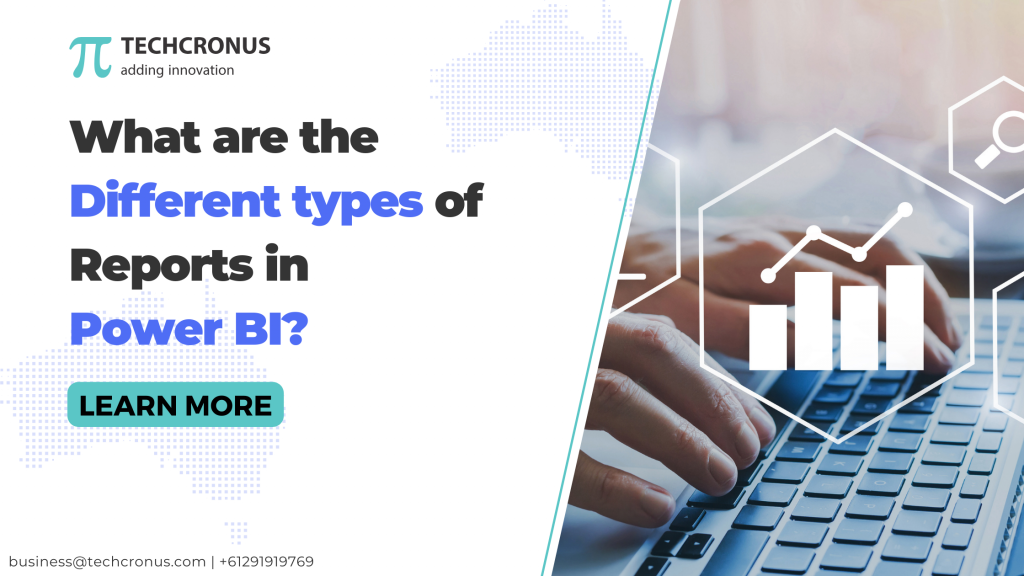What are the Different types of Reports in Power BI?
In today’s digital era, businesses no longer rely solely on raw data for growth. With the advent of interactive BI tools, such as Power BI, we can effortlessly transform intimidating data into valuable insights. Power BI has emerged as a trusted BI platform for modern enterprises.
Power BI allows users to easily build reports, providing a detailed view of any data stream. Its dashboards and reports enable users to access live data for evidence-based decision-making. The tool’s popularity continues to soar, given its remarkable capabilities.
Power BI Reporting services cater to both technical and non-technical users, facilitating data visualization, analysis, and utilization. Microsoft’s Power BI offers various types of reports to serve diverse domains and company sizes.
Regardless of your industry or company size, Power BI offers report types tailored to your specific needs.
In this blog post, we’ll explore the different types of Power BI reports to enlighten you on their versatility and applicability.
Types of Power BI Reports
Certainly! Here are six major categories of Power BI reports:
1. Digital Marketing Reports
Digital Marketing Reports in BI provide a concise summary of key performance indicators (KPIs) for digital marketing campaigns. These reports enable managers to optimize advertising budgets and enhance revenue potential effectively.
BI’s robust capabilities simplify the identification of issues and potential problem areas within marketing campaigns.
Any digital marketing report in Power BI offers the following benefits:
1. Comprehensive analysis and comparison of Cost Per Click (CPC) and Cost Per Thousand Impressions (CPTM).
2. Visualization of monetary expenditure on advertisements across different periods.
3. Clear visuals representing Bounce Rate and Cost Per Acquisition (CPA).
4. Insights into the average cost per click.
5. Comparison between Cost Per Acquisition and the total number of conversions.
These features empower organizations to make data-driven decisions, refine marketing strategies, and maximize the effectiveness of their digital marketing efforts.
2. Website Analytics Reports
The Website Analytics Report in Power BI encompasses all aspects of website performance. From delivering valuable insights into website performance to assisting the SEO team in analyzing website analytics, it covers a wide range of metrics. Daily, it focuses on the following website-related information:
Website Conversion: This section presents visitor behavior, short-term trends, sales conversion ratios, keyword rankings, and more.
Bounce Rate: Bounce rate measures the time spent by a visitor on a page or website. Additionally, it showcases average page views by visitors and the last page viewed.
Website Visits: This section displays data related to website performance, visitor metrics, site metrics, total new visits by date, and total visits by country.
3. Customer Profitability Reports
Customer Profitability Reports cater to business unit managers, providing visualization of various business metrics such as products, gross margins, and more. In a single view, users can comprehend all factors influencing profitability. Additionally, users gain access to top-tier company metrics including:
- Monthly organization gross margin
- List of existing customers
- Sales ratio of the top five products
- Revenue growth of products over the years
- List of regions with the largest revenue generation
4. Sales and Analysis Reports
Sales and Analysis Reports in Power BI serve as a valuable resource for the sales team, streamlining their workload. Users can download essential report samples for reference. This report facilitates the following:
- Analysis of various business trends across different periods
- Calculation of the company’s sales-to-total industry sales ratio
- Compilation of a competitors list
- Tracking of regions of business operation
- Calculation of year-to-date variance in total sales
5. HR Analytics Report
For valuable insights into the HR department, rely on Power BI’s HR Analytics Report. This report empowers HR professionals to make strategic decisions and formulate plans to enhance efficiency.
Key details provided by this report include:
- Tracking of new hires and attrition
- Distribution of qualified candidates across various locations
- Monitoring of active employees and new hire count
- Identification of hiring and attrition trends
6. Financial Analysis Report
The Financial Analysis Report is essential for the organization’s Chief Financial Officer (CFO), offering a comprehensive view of various financial metrics that streamline financial planning.
Key aspects covered by this report include:
- Gross Profit
- Assets
- Total Expenses
- Operating Income
- Liabilities
- Gross Margin
- Expenses
- Revenue
- Profit and Loss
These powerful Power BI reports cater to diverse organizational needs, providing valuable insights and facilitating informed decision-making across departments.
Conclusion:
Power BI is a formidable tool capable of significantly boosting your business growth. At Techcronus, we specialize in Power BI Consulting and can also assist you in assembling a proficient team of Power BI Developers. For further information, feel free to reach out to us.
